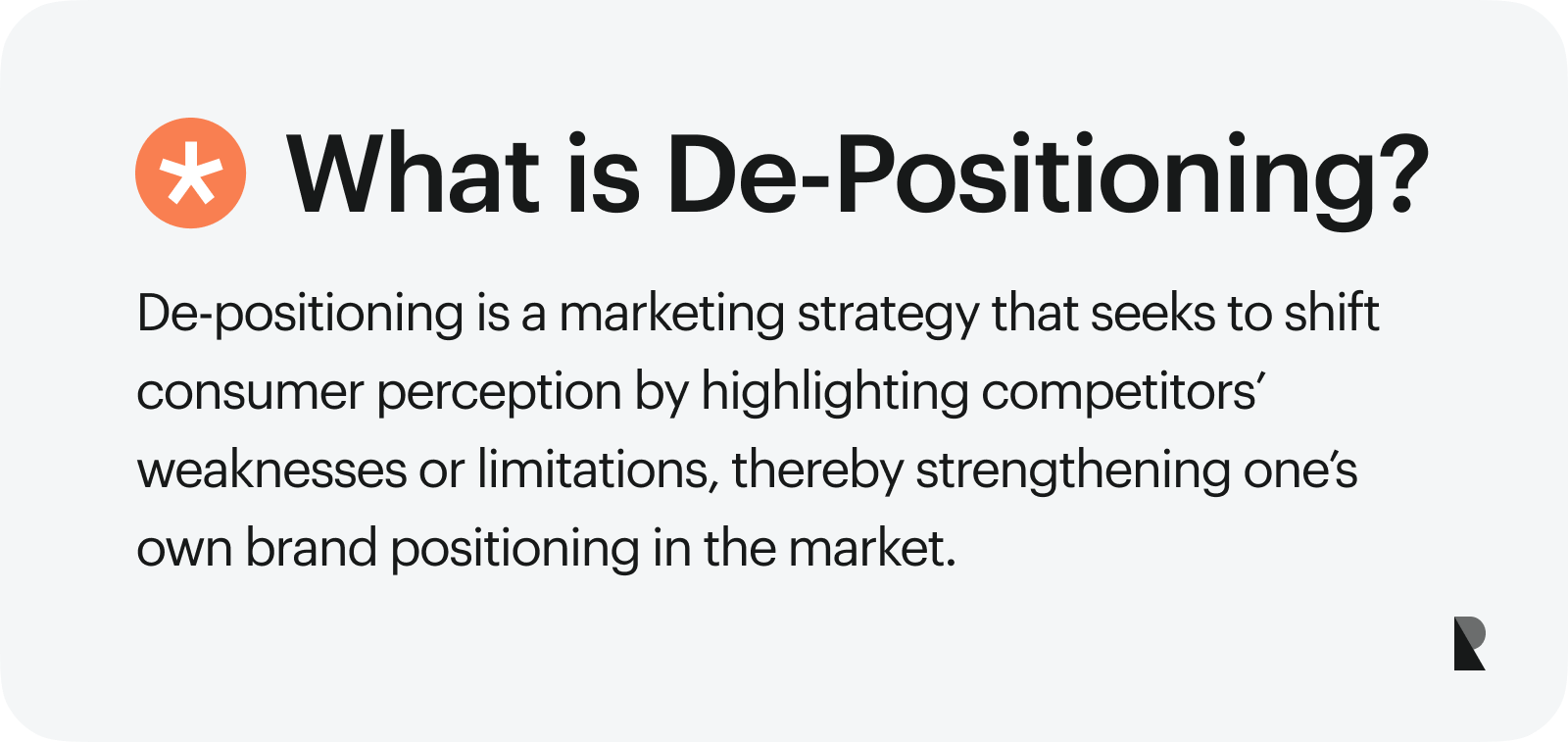
When every brand claims to be the best, the boldest move could be pointing out why others aren’t. This is the heart of de-positioning — a tactic that turns brand strategy on its head and spotlights competitor flaws instead of repeating your virtues. When you’re using it wisely, it can be one of the most effective marketing approaches.
If you’re curious about the topic, read on to learn more about the power of de-positioning: what it is, when to use it, and how to build a strategy around it that’s clear, credible, and targeted. For branding agencies and companies rethinking their positioning idea, this guide breaks it down with practical steps and examples. Let’s get into it.
De-Positioning vs .Brand Positioning
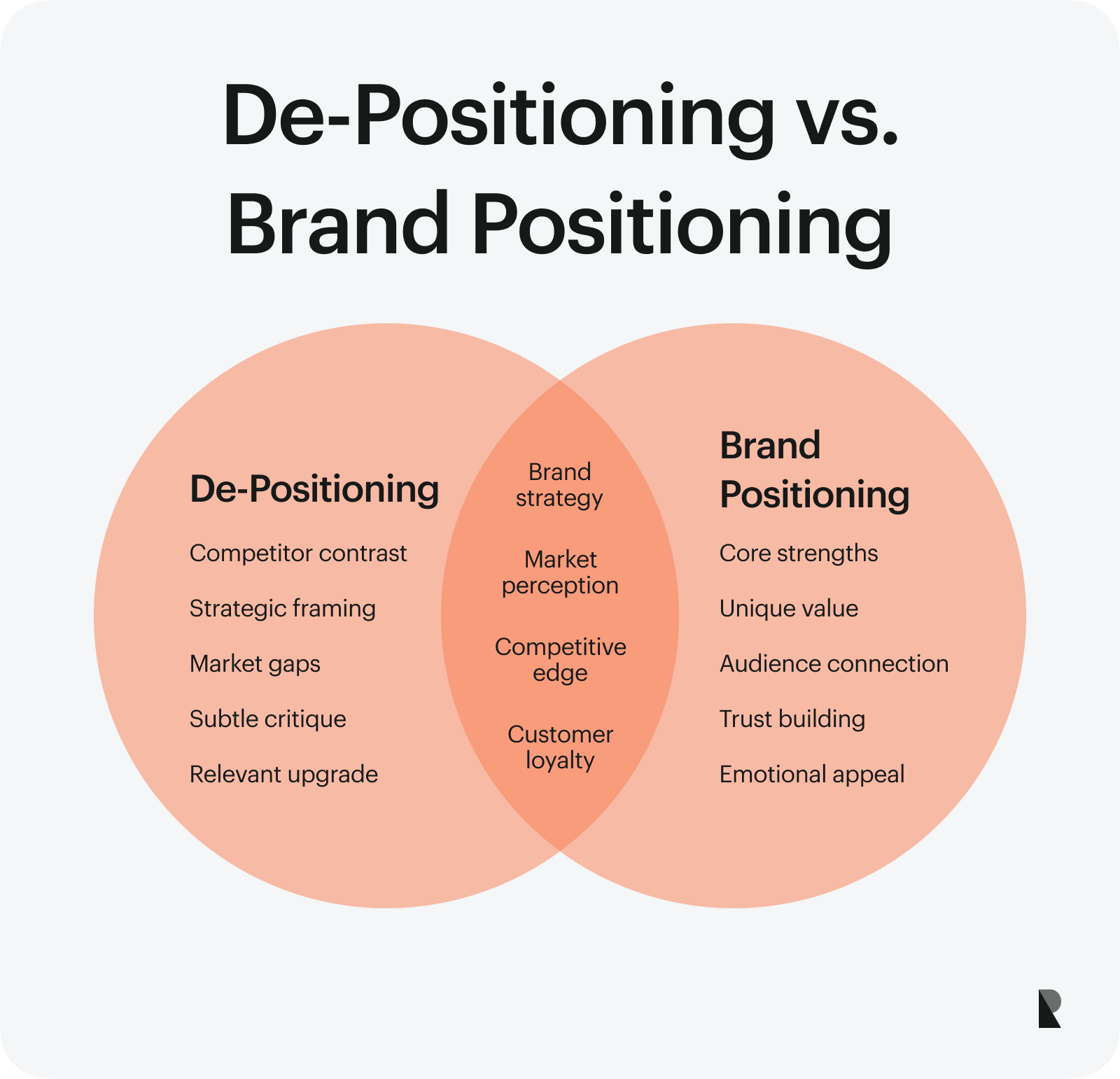
To understand the role of de-positioning in modern-day branding, it’s best to start by comparing it to traditional brand positioning. Both play a key role in any successful brand strategy, but they serve different functions in the buying journey. Where brand positioning helps define who you are, de-positioning defines who you aren’t—and why that actually matters.
What is brand positioning?
Brand positioning is the classic method of staking out space in a customer’s mind. It defines your brand’s core strengths, tone, voice, and unique selling propositions (USPs). Its goal is to shape perception to connect your solution with your audience’s pain points and deepest needs.
A strong brand positioning strategy is anchored in clarity. You’re showing the world why your product (or service) is valuable—not just functionally but emotionally. Over time, with consistency, that builds preference, trust, and loyalty.
What is De-positioning?
De-positioning stresses what others get wrong. It’s a way to position the competition, the “enemy” if you will — strategically and deliberately — so that your brand becomes the noticeable upgrade. Rather than focusing entirely on your positive features, you highlight what’s missing or broken elsewhere, and contrast that with what you deliver better.
It’s a method that often appears subtle on the surface, but underneath, it’s pointed and precise. De-positioning is not about attacking competitors outright. It’s about exposing what matters — and showing that your brand is the more relevant answer to those needs.
Famous Examples of De-Positioning
Some of the most memorable brand campaigns in recent history have succeeded not by shouting their own names but by quietly reframing the competition as the less desirable option. These brands didn’t just sell features. They sold a better context by focusing on what others failed to deliver.
Oatly vs. Cow’s Milk
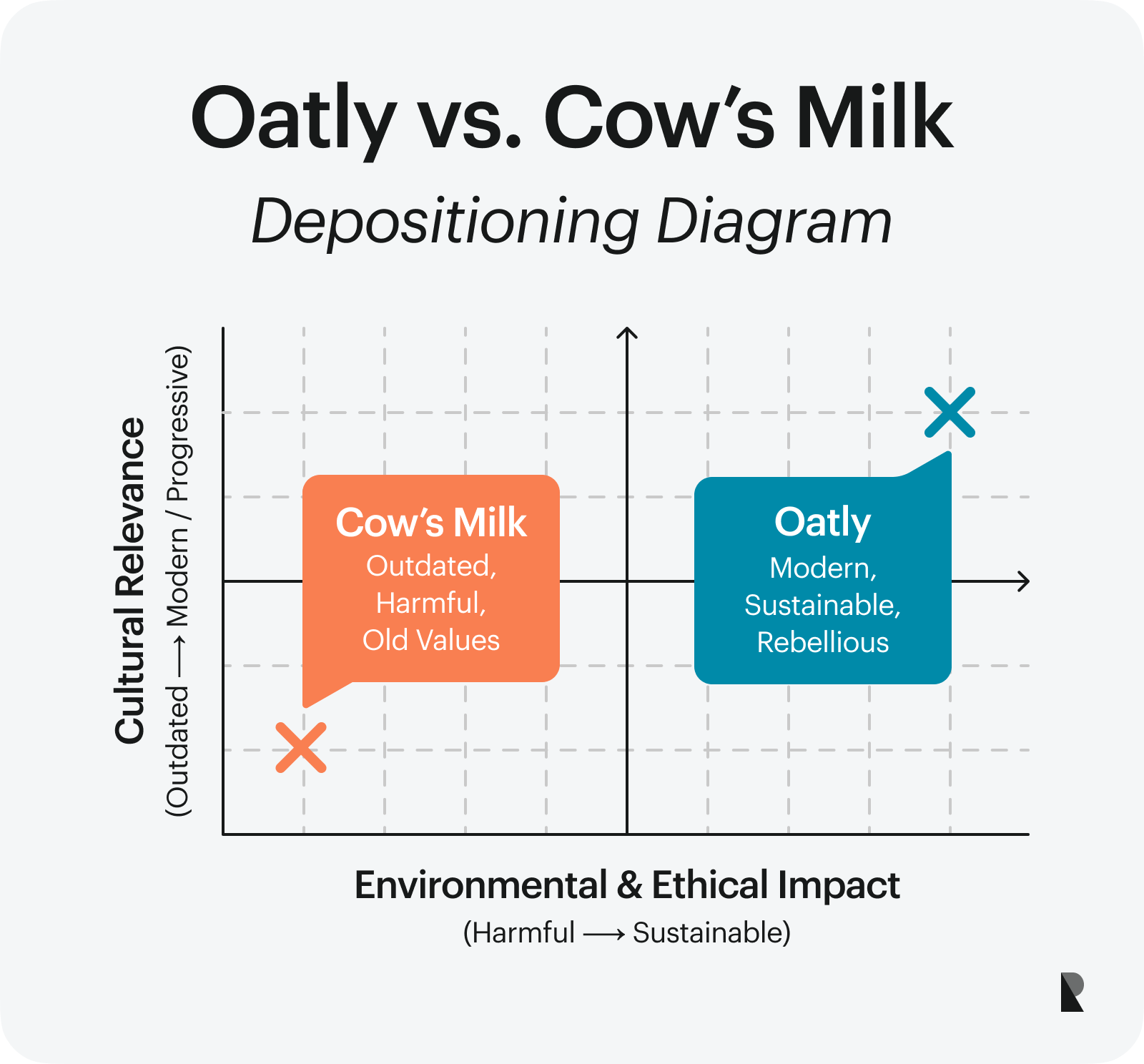
Oatly didn’t just say plant-based milk was healthy. Through tone, design, and messaging, it made the case that cow’s milk belonged to a bygone era. The cartons spoke like people. The headlines were cheeky, confident, and often critical of dairy’s environmental footprint.
Even without naming names, the message was clear: traditional milk is outdated, sour for the planet, and not aligned with modern values. Oatly de-positioned the entire dairy industry while giving people a new identity to buy into — one that felt aware, sustainable, and even a little rebellious.
### Apple vs PC
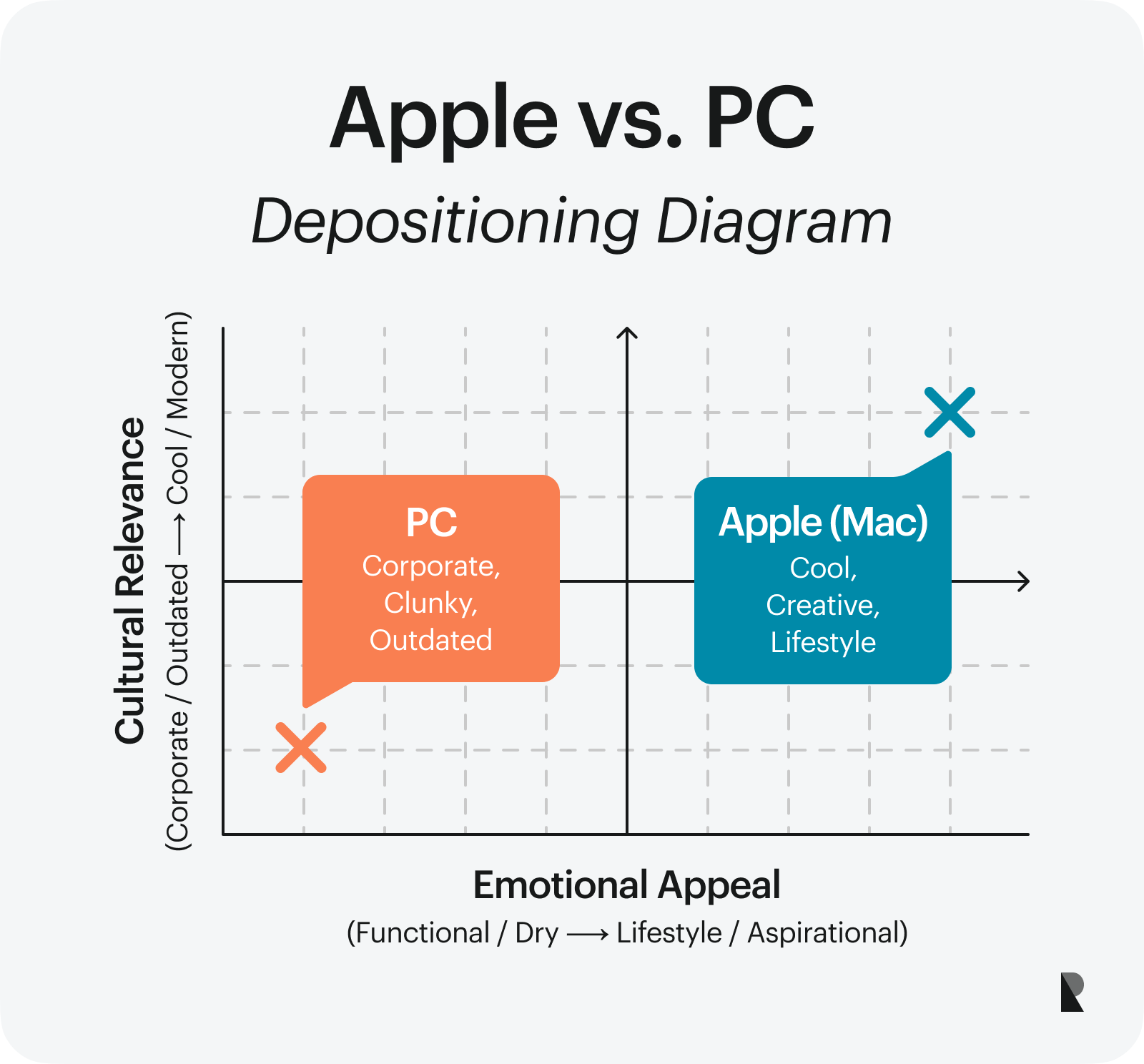
Apple In one of the most iconic de-positioning campaigns, Apple created two characters: Mac and PC. The PC was stiff, awkward, and constantly malfunctioning, while the Mac was relaxed, witty, and effortlessly cool.
Apple didn’t talk about RAM or battery life. It created a feeling that positioned PCs as clunky relics of corporate culture. That way, Apple made buying a Mac feel like a lifestyle decision rather than one about the tech.
Tesla vs. traditional automakers
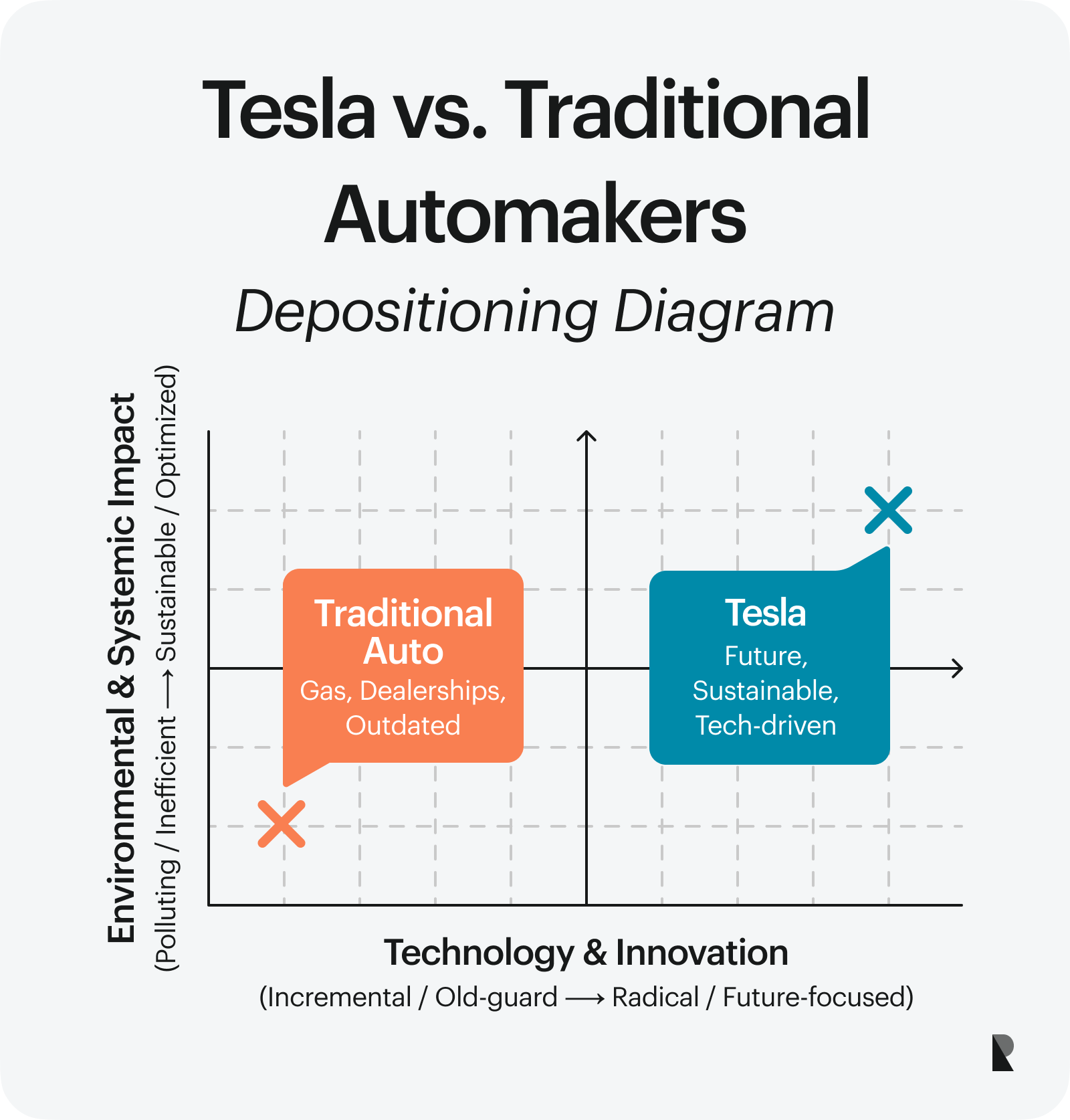
The rise of Tesla didn’t just come from electric motors or screen-filled dashboards where “everything’s computer.” It went from a quiet war against the assumptions of what a car should be.
Gasoline engines became symbols of inefficiency and environmental failure, and dealerships became unnecessary middlemen. With every touchpoint — from direct sales to over-the-air updates — Tesla positioned itself as the future and the old guard as a problem. That’s de-positioning at its sharpest.
Each of these brands used de-positioning to tap into dissatisfaction and then offered something just a little better. When the message is tied to a meaningful brand purpose and long-term brand strategy, it doesn't just change perception; it builds loyalty.
Traditional Positioning vs De-Positioning
Here’s a side-by-side comparison of the two strategies to understand how de-positioning changes the game.
| Traditional positioning | De-positioning |
|---|---|
| Highlights the brand’s own features | Highlights competitor weaknesses |
| Focuses on emotional and functional benefits | Focuses on what customers are missing elsewhere |
| Uses aspirational messaging | Uses contrast to show superiority |
| Speaks to a general target audience | Speaks directly to dissatisfaction with existing options |
| Leans on uniqueness and differentiation | Leans on comparative relevance and impact |
| Says: “Here’s why we’re great” | Says: “Here’s what they can’t do, but we can” |
Sometimes, pointing at the cracks in someone else’s wall is more compelling than polishing your own.
The Psychology Behind De-Positioning
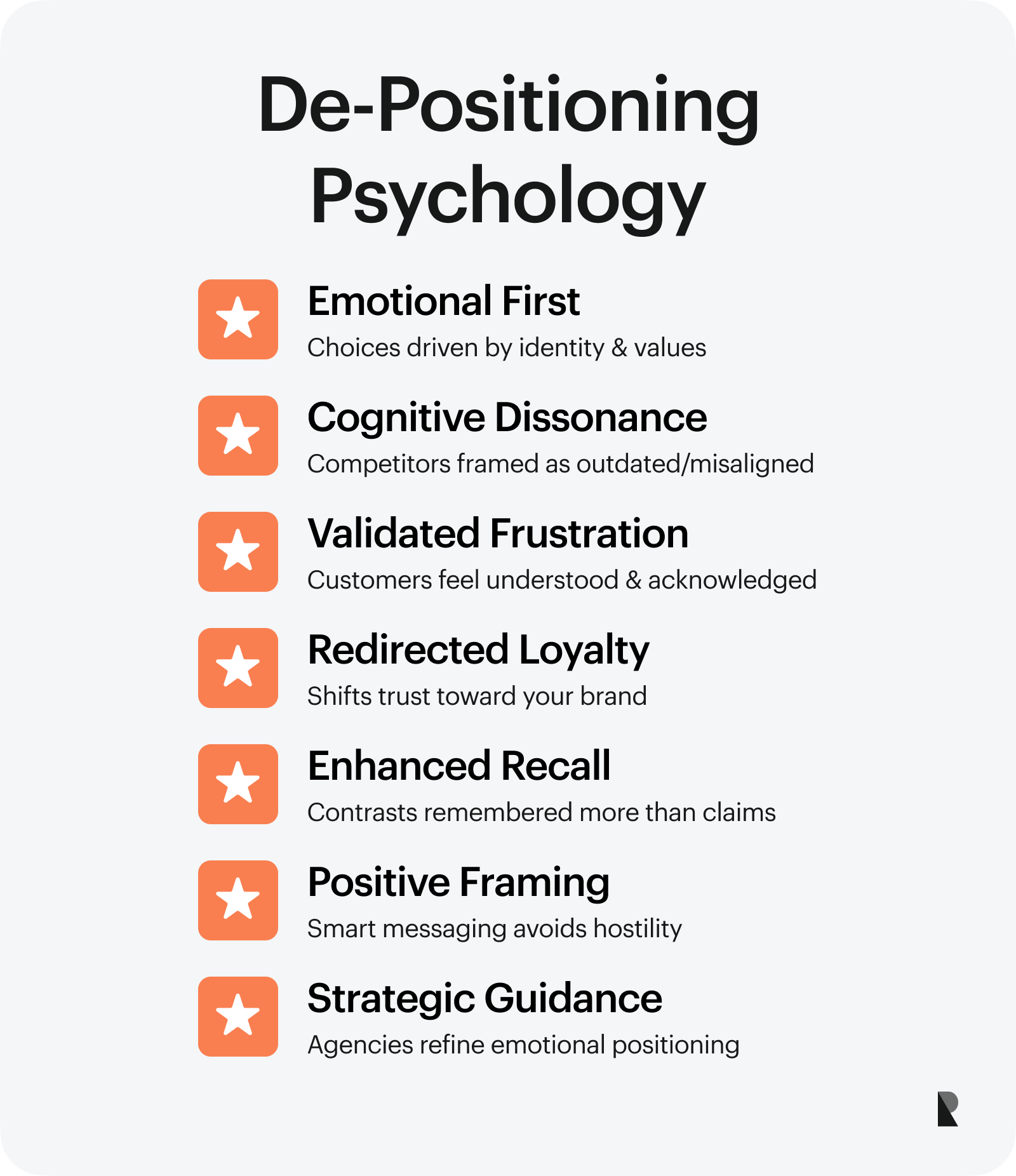
Effective de-positioning taps into how people make choices — emotionally first and rationally second. We like to believe that we buy based on logic, but research shows we gravitate toward brands that reflect our identity, values, or frustrations. That’s why de-positioning is such a high-value tactic in modern brand strategy.
By framing the competition as outdated, inefficient, or misaligned with customers' needs, you activate cognitive dissonance — the feeling that something isn’t adding up. That tension allows your brand to step in as the better fit.
De-positioning works because it validates frustration, redirects loyalty, and enhances recall. Customers feel seen when you call out industry flaws. They feel curious when a better solution is presented. And they remember contrasts far more vividly than stand-alone claims, especially when those contrasts speak to their deepest needs. In fact, collaborating with an experienced brand strategy consulting firm can help transform these insights into a structured narrative that highlights competitive weaknesses while elevating your core strengths.
If you're unsure how to shape this kind of emotional shift without veering into negative territory, a brand strategy aconsulting firm can be absolutely invaluable. A good one will help you shape emotionally intelligent messaging that positions your brand as the smarter choice without resorting to hostility. Their external perspective helps ensure that your message resonates with your audience, not just your team.
5 Steps to Get an Effective De-Positioning Strategy
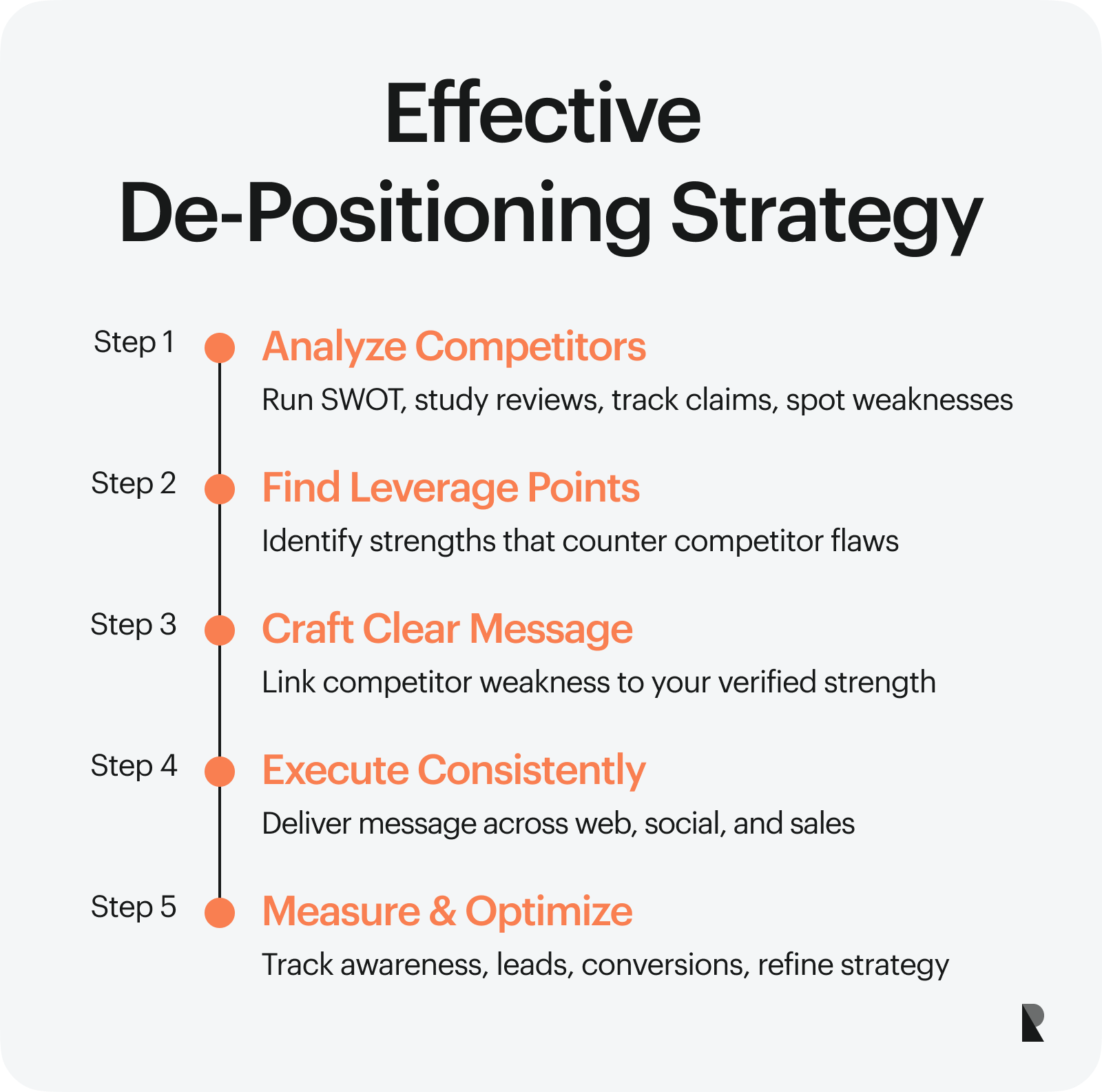
De-positioning isn’t guesswork. It’s a deliberate, structured process that aligns with your broader business strategy and brand purpose, and the best branding companies are increasingly using it to help brands stand out in saturated markets. Below is a step-by-step guide to doing it right, whether repositioning an existing brand or launching a fresh one.
1. Comprehensive competitor analysis
Before creating your message, you need to know who you're against — and what they’re saying. De-positioning starts with clearly understanding your competitors’ brand positions, promises, and gaps. To do this well:
- Run a SWOT analysis on each major competitor
- Look at customer reviews, especially 2- and 3-star ratings
- Analyze their ad campaigns, homepages, and landing pages
- Track repeated claims and themes — especially the ones they overuse or can’t back up
Your goal is to surface weak spots, clichés, or overpromises that your audience already suspects — but hasn’t yet had a better option to turn to.
2. Identifying your leverage points
Once you know the flaws in the competition’s messaging, the next step is to find your advantage. This isn’t just about naming features — it’s about identifying the specific ways your brand solves what others miss. Some common leverage points are:
- Faster onboarding or service delivery
- Transparent or no-surprise pricing
- Eco-conscious production or packaging
- Simpler, more intuitive UX
- Responsive customer service
- Smarter tools or automation
- Better data visibility and reporting
Try to match these with what you uncovered in your competitor research. The most effective de-positioning happens when you directly counter a known flaw with a proven strength.
3. Crafting a clear and credible message
Messaging is where many brands tend to lose their edge. To make your de-positioning strategy work, your story must be clear, credible, and creatively distinctive. Start with these steps:
- Identify a competitor's weakness that frustrates users.
- Link it to a specific, verifiable strength your brand offers.
- Write a statement that brings both together in a single line or idea.
This becomes the foundation of your de-positioning message. For example, saying “while others lock you in, we let you end your subscription at any time” is sharper and more persuasive than “we’re more flexible.” It tells a story, surfaces a pain point, and offers a solution — all in one.
The message must feel real. Back up your claims with data, testimonials, or case studies. Authenticity is an important element of any modern brand strategy, and it is especially critical when de-positioning others.
4. Executing across several touchpoints
A strong message needs a strong delivery system. De-positioning only sticks if it shows up consistently everywhere your audience interacts with your brand. Launch your campaign across:
- Social media (organic and paid)
- Website banners and comparison pages
- Landing pages and email sequences
- Sales decks and proposals
- Video and motion campaigns
- Contextual ads and retargeting
The message should be visually and verbally aligned everywhere. If your social ad positions the competition as slow and outdated, your landing page can’t suddenly talk in generalities about quality or care. Consistency creates clarity, and clarity builds trust.
This is especially true for branding agencies or teams that manage branding and performance simultaneously. Every channel needs to reinforce the same strategic message.
5. Measuring and optimizing results
You’ve done the research, shaped the message, and launched the campaign — now it’s time to prove it’s working. Make sure always to track these core metrics:
- Brand awareness
- Engagement rate
- Lead volume and quality
- Conversion rate
- Sales trends
- Share of voice vs key competitors
Set up dashboards and monitoring tools across web, social, and CRM. Watch how your audience responds. Look for improvements not just in volume, but in the type of conversations you're generating. Are prospects repeating your message back to you? Are sales calls better?
Optimization should be continuous. Test variations of your de-positioning idea — different headlines, CTAs, or visuals — and double down on what is performing well. The most effective approach is rarely static. It evolves with the audience in real time.
Leveraging De-Positioning Digitally
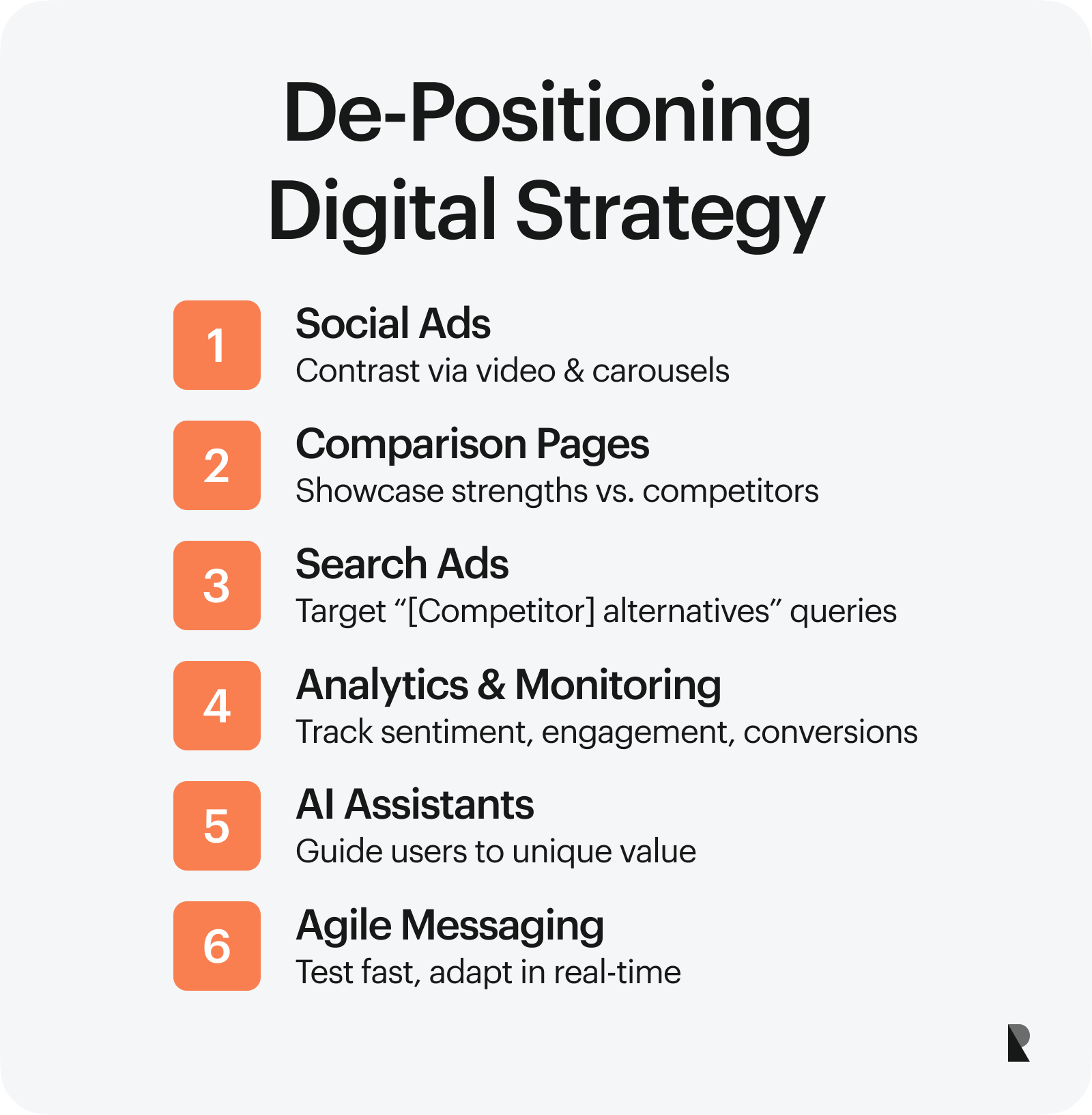
As you can imagine, digital platforms are uniquely suited for de-positioning because they allow for speed, specificity, and constant iteration. You can test dozens of positioning angles, refine your message mid-campaign, and speak directly to different segments — all without reinventing your core idea. Here’s how to use de-positioning online:
- Use social media to run contrasting video or carousel ads.
- Launch comparison pages that pit your product against alternatives.
- Run contextual search ads for terms like “[Competitor] alternatives” or “[Pain point] solution.”
- Use Google Analytics and social monitoring tools to track performance, sentiment, and engagement.
- Build voice assistants or chatbots into your site that guide users away from competitor traps and toward your unique selling points.
Speed of feedback is a massive advantage here. If a message hits, you’ll see it quickly; if it doesn’t, change it. You’re not bound to a static campaign. De-positioning lives best when it’s agile, timely, and built to adapt.
Conclusion
De-positioning doesn’t replace traditional positioning — it sharpens it. It creates emotional contrast, market clarity, and brand memorability. It’s one of the most effective approaches to shift customer perception and increase brand relevance in competitive categories. If your brand struggles to stand out, repeating your strengths louder won’t help. Positioning the competition reasonably and strategically can help.
It’s especially powerful during moments of important decisions in the buying journey. When the customer compares options, second-guesses their current tool, or reevaluates brand purpose, that’s your cue. A smart de-positioning message shows that what others offer isn’t enough — and that your brand delivers something bigger.
Jul 10, 2025
